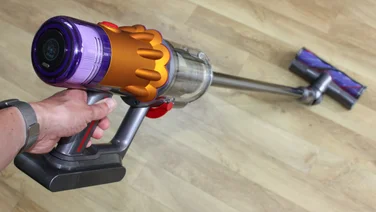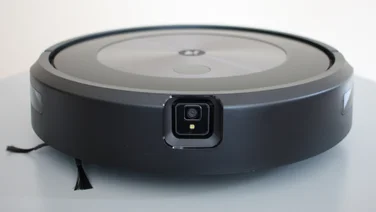To help us provide you with free impartial advice, we may earn a commission if you buy through links on our site. Learn more









- Surprisingly good spot cleaning
- Good value
- Compact and manoeuvrable
- Poor navigation
- Doesn’t remember maps
- No brush bar
Many new robot vacuum cleaners come with new and interesting features we haven’t seen before. However, the Lefant M210P takes a different approach. This robot doesn’t include such luxuries as self-emptying, obstacle detection, LiDAR mapping or mopping. It doesn’t even have a brush roller in the base, instead relying on a soft rubber skirt to gather dirt towards a hole in the base that feeds directly into the connection bin.
As a result of all this cutting back, though, it’s one of the most affordable robot vacuum cleaners you’ll find on Amazon.
Lefant M210P review: What do you get for the money?
Physically, the Lefant M210P is one of the smallest robot vacuum cleaners we’ve seen to date. Not only is it shorter than most rivals, its lack of a LiDAR turret means it stands a diminutive 75mm tall – but it’s narrow, too. It maintains the traditional hockey puck shape so beloved of robot vacuums but the diameter is a relatively compact 280mm.
Despite that, Lefant hasn’t compromised too much on the bin capacity. This is a bit smaller than average at 500ml (most robot vacuums offer 600-700ml) but considering it’s housed in such a small device it’s not as small as it could have been.









That’s probably due to the fact that, unlike most other robot vacuums, the M210P lacks a brush bar. On a positive note, this means you never have to clean hair off it, although we still found some wrapped around its two edge sweepers after testing. On the other hand, it also means it can’t agitate your carpet and loosen dust from the fibres as effectively as a vacuum that does have one.









Suction isn’t bad, and is rated by Lefant at 1,800Pa. That’s less than half the suction of some of the most powerful robots we’ve seen but, again, that’s reflected in the low price. Beyond that, the vacuum is typically basic. It comes with a charging station, with a disappointingly short 1.5m mains lead, one spare filter and a pair of extra corner sweeping brushes, but that’s your lot.
READ NEXT: The best robot vacuum cleaners to buy today
Lefant M210P review: What is it like to use?
Setting up the Lefant M210P is relatively painless. Use the smartphone app (available for Android and iOS) to connect the robot to your Wi-Fi and it’s ready to go. The robot only has one visible button, which lets you start or pause the device; all its other functions are controlled by the app.









Although this is the same app that’s used across all Lefant’s robots, you don’t get the same experience as you do with the company’s more expensive robots. For example, while the LiDAR-equipped Lefant M1 stores its maps in the app, the M210P (which doesn’t use the same technology) can’t do that.
Start your first clean and the robot sets off exploring, building a map of its surroundings as it goes. It does this by tracking its movement so, in default mode, it will traverse across the room in straight lines, stopping if it bumps into things, then turning around and trundling off in a different direction.
You can watch the robot’s progress from the app but you can’t see in advance where the robot is going to go, as you can with models that scan ahead using LiDAR. This means there’s no opportunity to set no-go areas ahead of its arrival in tricky areas such as cable nests, so you need to make sure your floor is clear of any hazards before you set it off.









The fact that it doesn’t save its maps means you can’t set future no-go areas either, and there’s also no other way to block its path that doesn’t involve shutting a door or placing some other physical barrier in its way. You can’t, for instance, use magnetic strips to create barriers as you can with the Eufy RoboVac G20. In a nutshell, if you’re going to use this robot and have it operate on a schedule, you need to make sure your floor is kept tidy.
Not having a persistent map also means that if you want the robot to head to a specific space, you need to steer it there yourself. You can do this in the app using the remote control, which lets you trundle the robot forwards and backwards, or rotate it left and right. However, it’s easier and quicker to simply pick it up and physically carry it to where you want it.
The point of doing this is to perform a spot clean: a feature that’s hidden away in the remote control menu. Set the M210P down on a particular spot and the robot will spiral out away from the centre, then turn around and come back in again. It’s a sensible pattern that helped the M210P perform well in our cleaning tests.
Lefant M210P review: Is it good at finding its way around?
It’s navigation that really lets the Lefant M210P down. If you want a robot that you can drop in a room, have it bumble around cleaning as it goes, then put away again, then the M210P can do a decent job. Unfortunately, my house has a complex floor plan and the M210P struggled with it. At no point during testing did I manage to get the robot to automatically traverse my entire ground floor.
The problem appears to be that the robot doesn’t use its internal map effectively. Other robots that use this kind of basic live mapping system, such as the Eufy RoboVac G30, seem able to carve out areas to clean, then understand where they have and haven’t been. The M210P, on the other hand, can only work in straight lines or randomly bounce around. Neither of these are particularly good ways of ensuring that all areas of your floor are covered. In my analysis of this robot’s motion, it seemed to get hung up on going over the same patches until it ran out of battery power and needed to recharge.
Getting the robot back to the charger is another challenge that it doesn’t handle well. In my testing it needed to get through a number of doors and perform u-turns to return to the charging base but it completely lost its way every time.









The issue here is that it doesn’t appear to remember where it set off from and can only head straight back to the charger if it has direct line of sight. If it can’t see the charger, it relies on random movement and the flawed assumption that following a room edge will eventually get it back home. I once found it endlessly circling around the kitchen island, clearly assuming it had found the edge of the room.
What does all this mean? If you want a robot to clean one or two rooms, which aren’t too complicated to travel between, it can probably do the job. Anything more tricky and you’ll want to invest in something that can navigate better.
READ NEXT: The best cordless vacuums to buy right now
Lefant M210P review: How well does it clean?
While the navigation skills of the Lefant M210P are disappointing, its cleaning power offers a ray of hope. I put the little robot through our usual set of robot vacuum tests, challenging it with measured spillages of rice and flour, on both short-pile carpet and hard floor.
To perform this, I used the spot clean function in the app. This works best when the robot is placed directly on top of the spill, which gives it a chance to gather some of the food as soon as it starts moving, before the edge brushes scatter it or the tyres pick it up and spread it around.
As I’ve already mentioned, the M210P’s spot cleaning is simple but effective. It works in a spiral, starting in the middle, working its way out until it’s covered an area with a diameter of about a metre, then spirals back to the centre again. This provides the opportunity to gather anything that’s scattered early on, and a chance to clean up its own tracks on the way back in.









It worked particularly well with rice. On carpet, the scatter was fairly minimal and my kitchen scales measured a 100% collection of my 50g spillage of rice. There were a few grains still scattered beyond the reach of the vacuum but it was less than 1g. On hard floor, the robot scattered the rice grains a little further out of reach but it still performed exceptionally well, collecting 98% of the test spill.
Testing with fine particles (flour) proved much tougher. On hard floor, only 80% of the spill made it into the collection bin, leaving a neat pile pushed up against the rubber skirt behind the suction port. That’s still above average but it proved less successful on carpet, gathering a mere 62% of the spill. Without a brush to agitate the carpet, there’s only so much the M210P can do in this test.
Surprisingly, it performed better in these cleaning tests than the more expensive Lefant M1 but, for the price, you can still do better. As you can see from our chart, the Eufy RoboVac G20 does an even better job of spot cleaning, and is available for less.









Lefant M210P review: Should you buy it?
If you have a small space to clean and you want a cheap robot vacuuming solution, the Lefant M210P could fit the bill. Its cleaning is surprisingly capable, despite its mechanical simplicity, although that’s largely related to its spot cleaning skills.
Where it falls down, however, is navigation. In attempting to clean a larger space, this vacuum just couldn’t find its way around well enough. Its mapping only shows you where it’s been, with little intelligence applied to seeking out areas it hasn’t covered. And if it can’t find its way around it isn’t going to be able to show off its cleaning skills, which makes it tough for us to recommend buying.
The simple conclusion is to opt for one of the many more effective and cheaper robot vacuums. The Eufy RoboVac G20, like the M210P, isn’t brilliant at navigating but it performed better in our cleaning tests and, at the time of writing, was available on Amazon for £165.
For better navigation it’s advisable to spend more money on a robot with LiDAR. We like the Eufy RoboVac X8 for this kind of work. You’ll need to pay twice the price but it’s worth it for larger homes.







